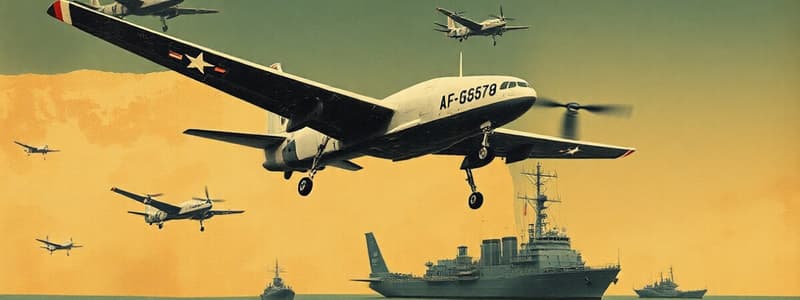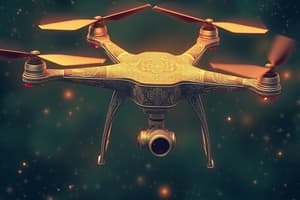Podcast
Questions and Answers
The use of flying objects or unmanned aerial vehicles in the U.S. can be traced back to which war?
The use of flying objects or unmanned aerial vehicles in the U.S. can be traced back to which war?
- World War II
- Civil War (correct)
- World War I
- Vietnam War
What challenge did the early pioneers of unmanned flight mainly face?
What challenge did the early pioneers of unmanned flight mainly face?
- Arranging control surfaces
- Controlling the aircraft in the air (correct)
- Designing fuselage structures
- Developing power plants
Which event put intense pressure on inventors and scientists to innovate in flight technology?
Which event put intense pressure on inventors and scientists to innovate in flight technology?
- World War II
- World War I (correct)
- Vietnam War
- Civil War
In 1916, which company was hired by the U.S. Navy to develop an unmanned torpedo?
In 1916, which company was hired by the U.S. Navy to develop an unmanned torpedo?
What was the name of the world's first unmanned aircraft system?
What was the name of the world's first unmanned aircraft system?
The Navy Research Lab developed which radio-controlled drone in the late 1930s?
The Navy Research Lab developed which radio-controlled drone in the late 1930s?
Which war accelerated the development of aviation science and unmanned aircraft?
Which war accelerated the development of aviation science and unmanned aircraft?
During which war did the most extensive unmanned program occur?
During which war did the most extensive unmanned program occur?
What operations utilized Fire Scout and Scan Eagle platforms in recent years?
What operations utilized Fire Scout and Scan Eagle platforms in recent years?
What is a typical use for unmanned systems in modern times, as discussed in the text?
What is a typical use for unmanned systems in modern times, as discussed in the text?
Flashcards
Unmanned Aerial Vehicles (UAVs)
Unmanned Aerial Vehicles (UAVs)
Flying vehicles without a human pilot on board.
World War I Impact on Unmanned Flight
World War I Impact on Unmanned Flight
Innovations in power plants, fuselage structures, lifting wing configurations, and control surface arrangements.
Curtis N-9
Curtis N-9
The first unmanned aircraft system was successfully launched by the US Navy.
UAVs in the Vietnam War
UAVs in the Vietnam War
Signup and view all the flashcards
Fire Scout and Scan Eagle
Fire Scout and Scan Eagle
Signup and view all the flashcards
Modern UAVs
Modern UAVs
Signup and view all the flashcards
MQ-4C Triton
MQ-4C Triton
Signup and view all the flashcards
Study Notes
Navy's Use of Unmanned Aerial Vehicles
- UAVs date back to the Civil War where both the Union and Confederate forces launched balloons laden with explosives on ammunition depots.
- UAVs have been called: aerial torpedo, drone, radio controlled vehicle, autonomous controlled vehicle, and unmanned aircraft system.
- Controlling UAVs while in the air was a key challenge for early pioneers of unmanned flight.
- World War I caused intense innovation in flight, including power plants, fuselage structures, wing configurations, and control surface arrangements.
- In late 1916, the U.S. Navy hired the Sperry Gyroscope Company to develop a flying unmanned torpedo.
- On 6 March 1918, the Sperry Gyroscope Company succeeded in launching an unmanned torpedo that hit its target 1,000 yards away.
- This successful flight produced the world’s first unmanned aircraft system, the Curtis N-9.
- In the late 1930s, the Navy returned to UAV development, where the Navy Research Lab developed the Curtis N2C-2 radio-controlled drone.
- The 2,500 lb, Curtis N2C-2 biplane was used to test the efficiency and accuracy of the Navy’s anti-aircraft defense system.
- World War II accelerated the advancement of aviation science and unmanned aircraft.
- Both the Allies and Germans successfully utilized unmanned aircraft during World War II
- The most extensive unmanned program occurred during the Vietnam War.
- Advances in technology made unmanned vehicles more effective and practical during the Vietnam War
- Drones were flown extensively during the Vietnam war for: reconnaissance, intelligence missions, leaflet drops, and surface-to-air missile radar detection.
- In recent years, the Fire Scout and Scan Eagle platforms were used during Operation Enduring Freedom and Operation Iraqi Freedom from multiple ground and sea-based platform
- Unmanned systems are typically utilized for surveillance or dangerous work where technology is preferable to risking a human life.
- Unmanned systems continue to increase the time they can stay in the air and improve warfighting capabilities.
Studying That Suits You
Use AI to generate personalized quizzes and flashcards to suit your learning preferences.





